One of the two ‘Breakout’ sessions that we attended was covering AR and VR applications.
 Natalie Walther, who heads up the Workstation group in FTS in Europe, made the introductions and started by saying that AR & VR are not new but really came into the mass market with the Oculus Rift which radically reduced the cost of getting started in VR.
Natalie Walther, who heads up the Workstation group in FTS in Europe, made the introductions and started by saying that AR & VR are not new but really came into the mass market with the Oculus Rift which radically reduced the cost of getting started in VR.
 Thomas Bretthauer is Head of Global Product Management for Workstations at Fujitsu and he agreed with Walther that the new pricing of AR and VR is really opening up the market. He defined the “Reality spectrum” based on work done by an academic, Paul Milgram.
Thomas Bretthauer is Head of Global Product Management for Workstations at Fujitsu and he agreed with Walther that the new pricing of AR and VR is really opening up the market. He defined the “Reality spectrum” based on work done by an academic, Paul Milgram.
At one extreme there is the “Real Environment” and if you add data to that reality, it becomes Augmented Reality if the environement becomes interactive. At the other extreme is Virtual Reality which completely replaces the world around us. Audio and haptics help users to completely forget the real world. Add some real world data to that Virtual world and it becomes, in Milgram’s classification, Augmented VR, but all of them except the Real Environment are, effectively, Mixed Reality.
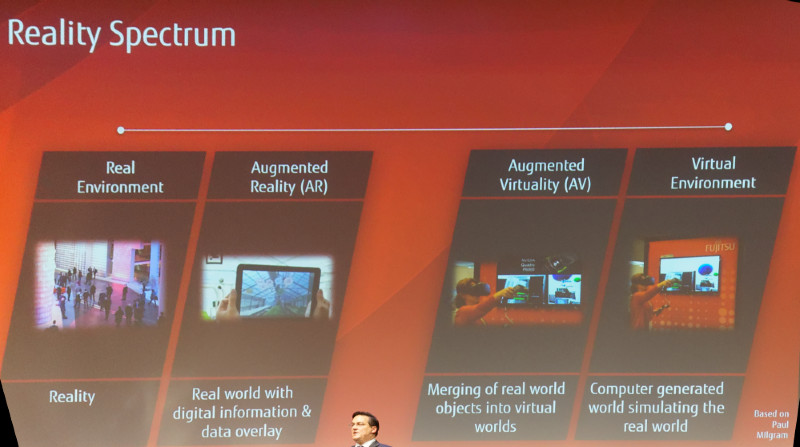 Brettauer defined the VR Spectrum. Image:Meko
Brettauer defined the VR Spectrum. Image:Meko
Early applications for VR and AR were in architecture and design – e.g. kitchen planning or planning buildings and facilities in detail, saving the cost of scale models. In medicine, VR training of doctors and nurses can be given without the ‘real world’ consequences of failing. In other training or education, VR can save cost. In retail, it can be used to assist the decision making process, for example by offering a “virtual configurator” for cars.
AR and VR can provide a “human-centric” interface for IoT applications and Bretthauer described the HMD already developed by Fujitsu for several years. It is now supported by Fujitsu Amplify software (for more see our round-up report).
What device should be used for AR and VR, Bretthauer asked? For 360 video or pre-rendered content a smartphone will do, but more immersion means a need for better devices. High frame rates and resolution mean a lot of pixels – up to 400 million pixels/second so you need a powerful workstation and Fujitsu makes those in Augsburg.
 Different VR applications need different devices. Image:Meko
Different VR applications need different devices. Image:Meko
 Andy Hendry who is from Nvidia was the next speaker where he is a territory manager.
Andy Hendry who is from Nvidia was the next speaker where he is a territory manager.
He said that VR can accelerate workflows for designers and architects as well as giving a real sense of the feeling of the new product or design. Film and content makers will also see a big need for “virtual cinematography”, especially as content is likely to become more immersive.
However, images have to be a faithful representation of reality – that is why scale models are so important in many applications today. Virtual worlds have to act the same as they do in the real world. You need to be able to use components such as doors or isolate single components in a complex system.
Nvidia has released Holodeck as a platform for collaboration in a photorealistic world, with real world physics and with shared spaces. VRWorks software supplies over 1000 different calibrated materials and Hendry said that the application is “much more than a conference call” and users are able to share audible and visual cues.
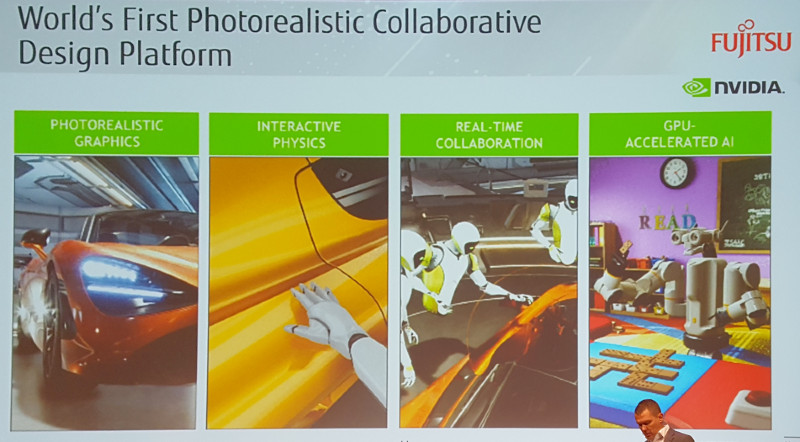 Nvidia’s Holodeck VR environment is open for applications. Image:Meko
Nvidia’s Holodeck VR environment is open for applications. Image:Meko
So what can you do in Holodeck? You can draw and annotate, measure parts, change the material of parts and colours on the fly. You can place assets within the experience and explode assemblies into components.
The Holodeck was announced at Nvidia’s GTC event and the company is now inviting designers and others to apply for access
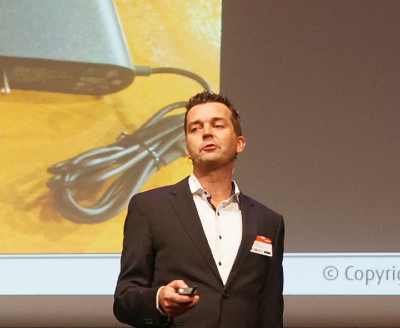 Michal Zawrel is Senior Product Manager for Mixed Reality and Hololens for Microsoft in Germany.
Michal Zawrel is Senior Product Manager for Mixed Reality and Hololens for Microsoft in Germany.
Running VR can be very complex today because it can take hours to set up a VR environment, partly because of the need to set up trackers. However, this will be changed by Windows Mixed Reality, Zawrel said – just plug and play in less than 10 minutes. It takes only seconds to repeat the set up which makes it ideal for trade shows and other ‘pop-up’ events.
The Windows Mixed Reality platform supports up to 1440 x 1600 resolution at 90Hz and is also the cheapest technology for VR on the market.
Moving to the other end of the spectrum, there is the Hololens. Zawrel gave an example in production and design.
The domestic stairlift is an interesting product and costs quite a lot of money, but it needs a complex set up and an individual design for every staircase. Typically, the sales process is very slow as someone has to visit the home to measure it and this data has to be sent back to the office for processing, just to create a quotation.
 The use of Hololens has reduced stairlift time to installation by 75%. Image:Meko
The use of Hololens has reduced stairlift time to installation by 75%. Image:Meko
Thyssen Krup is using Hololens plus special software and a special ‘target’ for this market. The target is moved onto the end of each step in the stairs and photographed with the Hololens and that creates a virtual model. The salesman can showcase how it would work using the Hololens and this helps with sales. The system can send data to the cloud where it is processed by an Azure service and realtime and that makes the cost immediately available. The firm says that the process time from enquiry to installation is down to a quarter. No one can do it faster and speed of installation can be a big advantage where a consumer has suddenly got restricted mobility.
 Danny Tierney is a Technical Specialist with Autodesk in Munich. Autodesk has opened a fixed VR Center of Excellence in the city to showcase VR technologies. There have been more than 500 visitors so far in engineering, media and entertainment. VR is not just a headset but the company has also created a kind of 3D CAVE simulation using passive stereo displays with headtracking. The system uses four single, but linked, displays to show different views of the mode. CAVEs are great, Tierney said, but expensive.
Danny Tierney is a Technical Specialist with Autodesk in Munich. Autodesk has opened a fixed VR Center of Excellence in the city to showcase VR technologies. There have been more than 500 visitors so far in engineering, media and entertainment. VR is not just a headset but the company has also created a kind of 3D CAVE simulation using passive stereo displays with headtracking. The system uses four single, but linked, displays to show different views of the mode. CAVEs are great, Tierney said, but expensive.
Autocad has also developed a tracking system to allow movement using a tracked controller in 3D worlds – 2D has been OK for design in the past, but Autodesk believes that 3D is essential for the future.
The company has also developed a system of AR that is screen based. It captures a real model and uses mapping of different textures and materials onto an image of the model on the display. The system uses a big and powerful Fujitsu workstation with high refresh to allow the use of physically correct lighting. Up to a billion polygons can be displayed and still stay movable in real time, so the system is very powerful.
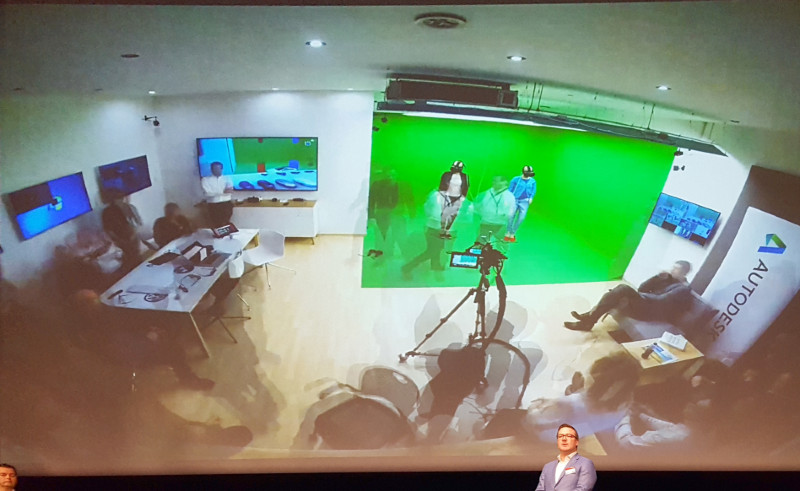 Autodesk has a dedicated green screen installation in Munich. Image:Meko
Autodesk has a dedicated green screen installation in Munich. Image:Meko
Collaborative VR is an interesting application and has almost unlimited capability in practical applications. Tierney showed how multiple individuals can be mapped into a single scene.
VR product designs, created with Autodesk products can be used and you can ‘just throw the model at the system’, he said, and it would run at 90fps. (Interestingly, in a discussion with Walther on the show floor later, she said that models needed to be properly set up for VR, which seemed to contradict this concept).
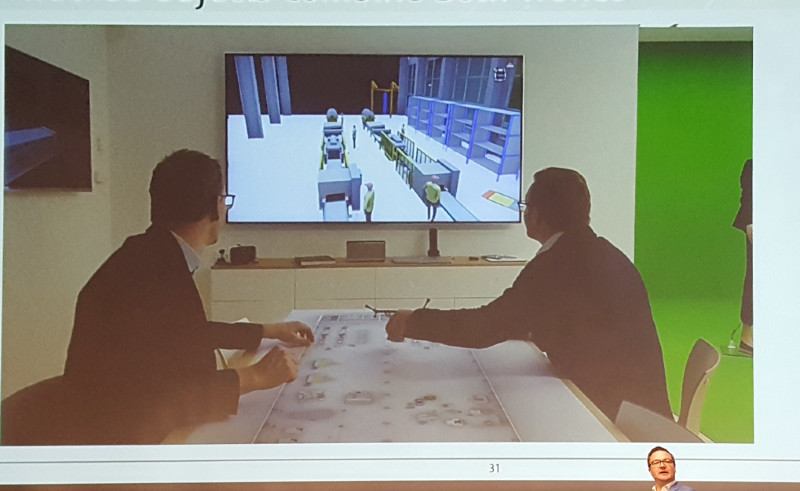 In this Autodesk modelling application the target is held over a 2D image of a model, and a 3D view is rendered from that position. Image:Meko
In this Autodesk modelling application the target is held over a 2D image of a model, and a 3D view is rendered from that position. Image:Meko
Analyst Comment
I would have preferred a bit more depth on these topics, but the stairlift case study was an interesting example of how AR and VR can accelerate business processes. I must try to arrange a visit to the Autodesk site when I am in Munich! (BR)

